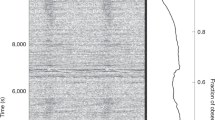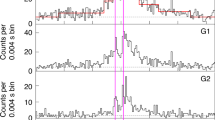Abstract
Typical radio pulsars are magnetized neutron stars that are born rapidly rotating and slow down as they age on time scales of 10 to 100 million years. In contrast, millisecond radio pulsars spin very rapidly even though many are billions of years old1. The most compelling explanation is that they have been ‘spun up’ by the transfer of angular momentum during the accretion of material from a companion star in so-called low-mass X-ray binary systems, LMXBs. (LMXBs consist of a neutron star or black hole accreting matter from a companion with mass less than one solar mass2.) The recent detection of coherent X-ray pulsations with a millisecond period from a suspected low-mass X-ray binary system appears to confirm this link3. Here we report observations showing that the orbital period of this binary system is two hours, which establishes it as an LMXB. We also find an apparent modulation of the X-ray flux at the orbital period (at the two per cent level), with a broad minimum when the pulsar is behind the low-mass companion star. This system seems closely related to the ‘black-widow’ millisecond radio pulsars, which are evaporating their companions through irradiation4,5,6,7,8. It may appear as an eclipsing radio pulsar during periods of X-ray quiescence.
This is a preview of subscription content, access via your institution
Access options
Subscribe to this journal
Receive 51 print issues and online access
$199.00 per year
only $3.90 per issue
Buy this article
- Purchase on Springer Link
- Instant access to full article PDF
Prices may be subject to local taxes which are calculated during checkout

Similar content being viewed by others
References
Backer, D. C., Kulkarni, S. R., Heiles, C., Davis, M. M. & Goss, W. M. Amillisecond pulsar. Nature 300, 615–618 (1982).
Bhattacharya, D. & van den Heuvel, E. P. J. Formation and evolution of binary and millisecond pulsars. Phys. Rep. 203, 1–124 (1991).
Wijnands, R. & van der Klis, M. Amillisecond pulsar in an X-ray binary system. Nature 394, 344–346 (1998).
Fruchter, A. S. et al. The eclipsing millisecond pulsar PSR 1957+20. Astrophys. J. 351, 642–650 (1990).
Nice, D. J. & Thorsett, S. E. Pulsar PSR 1744−24A: timing, eclipses, and the evolution of neutron star binaries. Astrophys. J. 397, 249–259 (1992).
Manchester, R. N. et al. Discovery of ten millisecond pulsars in the globular cluster 47 Tucanae. Nature 352, 219–221 (1991).
Deich, W. T. S. et al. The binary pulsar PSR 1908+00 in NGC 6760. Astrophys. J. 410, L95–L98 (1993).
Stappers, B. W. et al. Probing the eclipse region of a binary millisecond pulsar. Astrophys. J. 465, L119–L122 (1996).
in 't Zand, J. J. et al. Discovery of the X-ray transient SAX J1808.4−3658, a likely low-mass X-ray binary. Astron. Astrophys. 331, L25–L28 (1998).
Lewin, W. H. G., van Paradijs, J. & Taam, R. E. in X-Ray Binaries (eds Lewin, W. H. G., van Paradijs, J. & van den Heuvel, E. P. J.) 175–232 (Cambridge Univ. Press, 1995).
Marshall, F. E. SAX J1808.4−3658 = XTE J1808−369. IAU Circ. No. 6876 (1998).
Wijnands, R. & van der Klis, M. SAX J1808.4−3658 = XTE J1808−369. IAU Circ. No. 6876 (1998).
White, N. E., Nagase, F. & Parmar, A. N. in X-Ray Binaries (eds Lewin, W. H. G., van Paradijs, J. & van den Heuvel, E. P. J.) 1–57 (Cambridge Univ. Press, 1995).
Chakrabarty, D. & Morgan, E. H. SAX J1808.4−3658 = XTE J1808−369. IAU Circ. No. 6877 (1998).
Lyne, A. G. & Graham-Smith, F. Pulsar Astronomy (Cambridge Univ. Press, 1990).
Roche, P. et al. SAX J1808.4−3658 = XTE J1808−369. IAU Circ. No. 6885 (1998).
Giles, A. B., Hill, K. M. & Greenhill, J. G. SAX J1808.4−3658 = XTE J1808−369. IAU Circ. No. 6886 (1998).
Thorsett, S. E. & Chakrabarty, D. Neutron star mass measurements. I. Radio pulsars. Astrophys. J. (submitted); preprint astro-ph/9803260 at 〈http://xxx.lanl.gov〉 (1998).
van Kerkwijk, M. H., van Paradijs, J. & Zuiderwijk, E. J. On the masses of neutron stars. Astron. Astrophys. 303, 497–501 (1995).
Zhang, W., Strohmayer, T. E. & Swank, J. H. Neutron star masses and radii as inferred from kilohertz quasi-periodic oscillations. Astrophys. J. L167–L170 (1997).
1. Faulkner, J., Flannery, B. P. & Warner, B. Ultrashort-period binaries. II. HZ 29 (=AM CVn): a double-white-dwarf semidetached postcataclysmic nova? Astrophys. J. 175, L79–L83 (1972).
Savonije, G. J., de Kool, M. & van den Heuvel, E. P. J. The minimum orbital period for ultra-compact binaries with helium burning secondaries. Astron. Astrophys. 155, 51–57 (1986).
Paczynski, B. Gravitational waves and the evolution of close binaries. Acta Astron. 17, 287–296 (1967).
Tout, C. A., Pols, O. R., Eggleton, P. P. & Han, Z. Zero-age main-sequence radii and luminosities as analytic functions of mass and metallicity. Mon. Not. R. Astron. Soc. 281, 257–262 (1996).
Podsiadlowski, P. Irradiation-driven mass transfer in low-mass X-ray binaries. Nature 350, 136–138 (1991).
D'Antona, F. in Evolutionary Processes in Binary Stars (eds Wijers, R. A. M. J., Davies, M. B. & Tout, C. A.) 287–306 (Kluwer, Dordrecht, 1996).
Stella, L., Campana, S., Colpi, M., Mereghetti, S. & Tavani, M. Do quiescent soft X-ray transients contain millisecond radio pulsars? Astrophys. J. 423, L47–L50 (1994).
van Paradijs, J. On the accretion instability in soft X-ray transients. Astrophys. J. 464, L139–L141 (1996).
King, A. R., Kolb, U. & Burderi, L. Black hole binaries and X-ray transients. Astrophys. J. 464, L127–L130 (1996).
Verbunt, F. & van den Heuvel, E. P. J. in X-Ray Binaries (eds Lewin, W. H. G., van Paradijs, J. & van den Heuvel, E. P. J.) 457–494 (Cambridge Univ. Press, 1995).
Acknowledgements
We thank L. Bildsten, V. Kaspi, A. Levine, R. Nelson, R. Remillard, F. Rasio, S.Thorsett, M. van der Klis and B. Vaughan for discussions, and M. Muno for assistance with the data analysis. We also thank F. Marshall, J. Swank and the RXTE team at NASA/Goddard Space Flight Center for arranging these target-of-opportunity observations and the necessary follow-up. This work was supported by NASA.
Author information
Authors and Affiliations
Corresponding author
Rights and permissions
About this article
Cite this article
Chakrabarty, D., Morgan, E. The two-hour orbit of a binary millisecond X-ray pulsar. Nature 394, 346–348 (1998). https://doi.org/10.1038/28561
Received:
Accepted:
Issue Date:
DOI: https://doi.org/10.1038/28561
This article is cited by
-
Optical and ultraviolet pulsed emission from an accreting millisecond pulsar
Nature Astronomy (2021)
-
On the structure of quasi-Keplerian accretion discs surrounding millisecond X-ray pulsars
Journal of Astrophysics and Astronomy (2020)
-
High plasma cut-off frequency blocks the radio emission from accreting millisecond X-ray pulsar SAX J1808.4-3658
Astrophysics and Space Science (2020)
-
Swings between rotation and accretion power in a binary millisecond pulsar
Nature (2013)
Comments
By submitting a comment you agree to abide by our Terms and Community Guidelines. If you find something abusive or that does not comply with our terms or guidelines please flag it as inappropriate.



